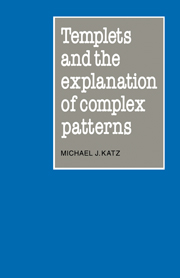Book contents
- Frontmatter
- Contents
- Prologue
- Introduction
- 1 Scientific abstractions
- 2 The nature of explanation
- 3 Configurational explanations
- 4 Templeting
- 5 Self-assembly
- 6 Rules for configurational explanations
- 7 Simple, complex and random
- 8 Reductionism
- Appendix: A pattern theoretic formalization
- Quotation index
- Subject index
3 - Configurational explanations
Published online by Cambridge University Press: 26 March 2010
- Frontmatter
- Contents
- Prologue
- Introduction
- 1 Scientific abstractions
- 2 The nature of explanation
- 3 Configurational explanations
- 4 Templeting
- 5 Self-assembly
- 6 Rules for configurational explanations
- 7 Simple, complex and random
- 8 Reductionism
- Appendix: A pattern theoretic formalization
- Quotation index
- Subject index
Summary
There is one ideal of survey which would look into each minute compartment of space in turn to see what it may contain and so make what it would regard as a complete inventory of the world. But this misses any world-features which are not located in minute compartments. We often think that when we have completed our study of one we know all about two, because ‘two’ is ‘one and one’. We forget that we have still to make a study of ‘and’. Secondary physics is the study of ‘and’ – that is to say, of organisation.
[A.S. Eddington (1929) The Nature Of The Physical World Macmillan, NY, pp. 103–4.]In A Child's Garden Of Verses, Robert Louis Stevenson wrote:
The world is so full of a number of things,
I'm sure we should all be as happy as kings.
The world is certainly bountifully supplied with different things, and while these all appear new and wonderful to a child, they have largely become old and familiar to an adult. A scientist, on the other hand, dreams of a balance between the child world and the adult world. The scientist would like most things to be old and familiar while a few things still remain new and wonderful.
The scientific pursuit is turning the new and wonderful into the old and familiar: a scientist tries to make the world around him understandable.
- Type
- Chapter
- Information
- Templets and the Explanation of Complex Patterns , pp. 33 - 46Publisher: Cambridge University PressPrint publication year: 1986



